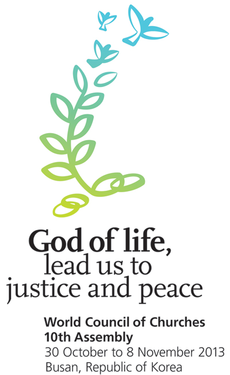World Council of Churches visits North Korean border
03 November 2013
On Saturday participants in the 10th Assembly of the World Council of Churches in Busan showed their solidarity with the people of Korea by means of peace messages. They visited the border between South and North Korea, which has divided the Korean peninsula for the past 63 years.
Since the Korean War (1950-1953) the Korean peninsula has been divided in two. There have been constant border clashes between capitalist South Korea and communist North Korea. There is no prospect of a rapid solution.
Kim Young-jin is a pastor in the Presbyterian Church in the Republic of Korea and is working as a volunteer at the Assembly. His family is from Kaesung, not far from the Korean border. At the outbreak of the Korean War his family were separated. His aunt and grandparents live in North Korea, and since then there has been no contact. ‘There are South Koreans who have no interest in the division,’ Kim says. Or, he adds, ‘They do have because they are worried about the financial burden that unification would bring.’ However, he does hope for unification soon. ‘As Christians we must believe in it and work for it,’ he says.
He is moved by the fact that the WCC participants, who have come from all over the world, have shown their solidarity. ‘It is important that the Korean situation is not forgotten and that as many people as possible come here and see for themselves what the division of the country means for people in Korea.’
At Imjingak, one hour from Seoul, visitors can look across to the North Korean border from a viewing platform. In clear weather they can see North Korean soldiers marching.
Participants in the Assembly prepared small coloured ribbons in the border area, which they attached to one of the nearer border fences. They had on them peace messages, prayers and wishes for the Korean people.
Barbed wire and soldiers – reminders of the division
In Korean cities such as Busan or Seoul there are no visible reminders that the Korean peninsula is still divided. At Imjingak, only a few kilometres from the North Korean border, the soldiers and the barbed wire were a reminder to many participants that the Korean conflict is still a present reality, just as it was sixty years ago. That is also what Garland Debner Pohl, from the Roman Catholic Church, also feels. She is an Assembly participant and has a personal link with the Korean conflict, as her husband served in the Korean War. At the outbreak of the war he had just begun his studies at a United States university. He was thus not compelled to fight, but enlisted voluntarily. ‘He wanted to go – as people said then – “in order to kill a few communists,”’ she said, shaking her head. ‘It was easily explained to a young man that communists were not human beings.’ However, her husband was never on the front line but worked on an American base.
She herself was still a child during the Korean War, but she still remembers reports in the newspapers about American soldiers with frostbite who had to have their feet amputated. ‘It was terrible to read that about our soldiers.’ But she adds that she never even gave a thought then about the situation of the people in Korea. ‘For me, as an American, it has been a special experience to come here,’ says Debner Pohl, now 75 years old. ‘I am filled with feelings of guilt.’ She hopes that a political change will come about as soon as possible. ‘That is what I am praying for.’
Official website of the WCC 10th Assembly
High resolution photos available via photos.oikoumene.org





